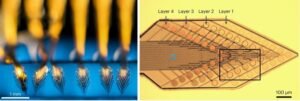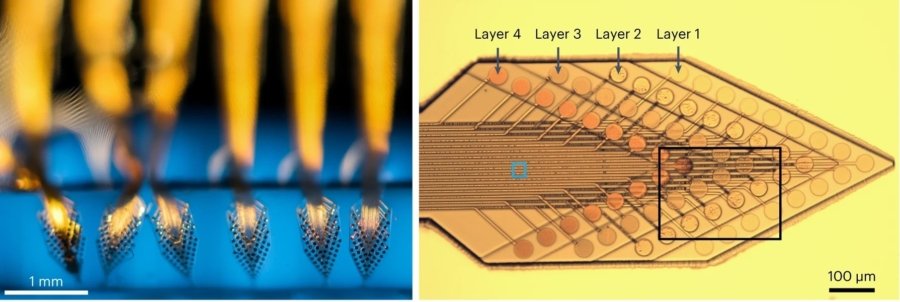An enduring neural probe
Researchers create an implantable gadget that has the ability to record a group of individual neurons over several months.
Large-scale, long-term recordings of the activity of individual brain neurons are essential for improving our knowledge of neural circuits, developing new medical device-based treatments, and, eventually, developing brain-computer interfaces that need high-resolution electrophysiological data.

However, there is now a trade-off between the length of time an implanted device may continue to record or stimulate performances and the amount of high-resolution information it can monitor. Although they may gather a great deal of data, rigid silicon implants with several sensors are unable to remain inside the body for very long. Smaller, flexible devices can stay in the brain longer and are less invasive, but they can only capture a small portion of the neuronal data that is there.
In collaboration with The University of Texas at Austin, MIT, and Axoft, Inc., an interdisciplinary team of researchers from the Harvard John A. Paulson School of Engineering and Applied Sciences (SEAS) recently created a soft implantable device with dozens of sensors that can record single-neuron activity in the brain steadily for months.
The study’s findings were released in Nature Nanotechnology.
With single-cell resolution, we have created brain-electronics interfaces that are more biologically compliant than conventional materials,” stated Paul Le Floch, the paper’s first author and a former graduate student in Jia Liu’s lab, an assistant professor of bioengineering at SEAS. The design of bioelectronics for brain-computer interfaces and neural recording and stimulation could be completely changed by this work.
As of right now, Le Floch serves as CEO of Axoft, Inc., a business that he, Liu, and Tianyang Ye—a former Harvard graduate student and postdoctoral researcher in the Park Group—founded in 2021. The intellectual property related to this research has been safeguarded by Harvard’s Office of Technology Development, which has granted a licence to Axoft for additional development.
Our work shows that innovative elastomers for long-term stable brain interfaces can be designed by carefully tailoring different parameters. This research may broaden the scope of neural interface design options.
— Jia Liu, a SEAS assistant professor of bioengineering
Fluorinated elastomers are a class of materials that the researchers used to address the trade-off between lifespan and high-resolution data rate. Teflon and other fluorinated materials are robust, stable in biofluids, exhibit outstanding dialectic performance over an extended period of time, and work well with conventional microfabrication procedures.
Stacks of soft microelectrodes totalling 64 sensors were combined with these fluorinated dielectric elastomers by the researchers to create a long-lasting probe that is 10,000 times softer than traditional flexible probes composed of materials engineering polymers like polyimide or parylene C.
The researchers recorded neuronal data from mice’s brains and spinal cords over several months to test the gadget in vivo.
Liu, the paper’s corresponding author, stated, “Our research shows that it is possible to design novel elastomers for long-term-stable neural interfaces by carefully engineering various factors.” “This research may broaden the scope of neural interface design possibilities.
Zhigang Suo, Boris Kozinsky, and Katia Bertoldi, three SEAS professors, were also members of the multidisciplinary study team.
According to Le Floch, “creating new neural probes and interfaces is a highly interdisciplinary problem that requires expertise in mechanical, chemical, electrical, and biological engineering.
Chanan Sessler, Guogao Zhang, Andrew Spencer, Jongha Lee, Tianyang Ye, Xin Tang, Xiao Wang, Nanshu Lu, Ren Liu, Nicola Molinari, Eder Medina, Hao Shen, Zheliang Wang, Junsoo Kim, Hao Sheng, Sebastian Partarrieu, Wenbo Wang, and Guogao Zhao co-authored the study.
Under Grant No. DMR-2011754 from the Harvard University Materials Research Science and Engineering Centre, the National Science Foundation provided support for this work.
